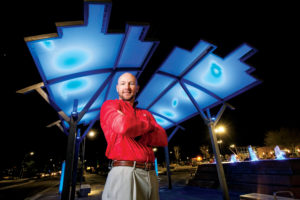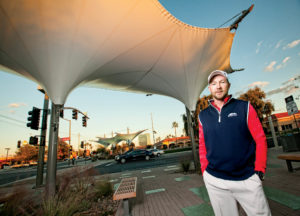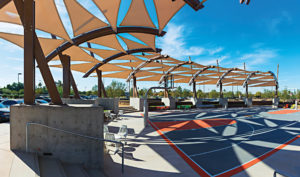Jacob Schwartz navigates the design and construction process by leveraging group strengths, examining all options and committing to long-term solutions for clients.

“Without exception, the more—and earlier—we are engaged in the design process, the more successful the fabric application becomes,” says Jacob Schwartz, owner and director of engineering and construction for International Tension Structures (ITS), Phoenix, Ariz. “Typically projects that require a more complex support structure and an ‘all hands on deck’ mentality to navigate through the design and construction process are a good fit for us—applications where we are able to roll up our sleeves and help solve a problem.”
Schwartz’s technical background consists of undergraduate degrees in environmental design and architecture with a minor in landscape architecture, while his post graduate degree is a master’s in business. He was working as a project manager for a general contractor in 2003 when he met Richard Henderson, then-owner of ITS, and the two hit it off right away. “There were a couple of things that stood out to me about Dick. First, he was a Type A personality, much like me,” Schwartz says. “Second was his attention to detail and the fact that he was adamant about doing things the right way.’ We were a couple of bulls in the room, telling it like it is.”
A NEW VIEW
Schwartz says it was an easy decision to hire ITS as a subcontractor because of Henderson’s no-nonsense approach and eye for excellence. Over time, Henderson became Schwartz’s friend and mentor, and in 2011 when Henderson was planning his exit strategy and succession plan for ITS, Schwartz came onboard as project manager. Soon after, Schwartz became director of engineering and construction, and purchased the company. “With my background in design and construction it seemed like a good fit for me. However, it was not an easy transition,” Schwartz says. “There were some changes I needed to make in myself in order to assume the reins.”
Adjusting his mindset to that of owner was initially challenging, Schwartz says. “To be honest, I really had to learn to kiss butt a little more. I was used to working hard, but being the guy on the other side of the table versus being the subcontractor was an adjustment,” he says. “But Dick and [his wife] Barbara worked side by side with me for several years and made the transition a success.”
Schwartz was fortunate to have a great network of skilled subcontractors when he worked on the general contracting side of the business, and he credits much of his success to those earlier relationships and the knowledge he gained while working closely with them to build some exciting projects. “Looking back, I learned a lot about building through developing good business relationships,” he says. “Now, I continue to build amazing relationships with great builders, but from the specialty subcontractor side.”
GOAL-BASED OPTIONS
Design development typically begins with an examination of the overall architecture of the project, and hosting a design charrette (intensive planning meeting) to work through every aspect of the design parameters. “We enjoy working on projects that have incorporated fabric as a central part of the architectural design as opposed to an afterthought that was slapped on late in the process,” Schwartz says.
While each charrette is unique, just as each project is distinct, the group assembled usually includes the ITS team, project architect and sometimes the owner and structural engineer. The group reviews how the existing style relates to what the client is trying to achieve with the fabric. “Too often people are sold something without even being given the range of solutions available to them,” Schwartz says. “We discuss all options, including opting out of fabric in lieu of another application if that’s what’s needed. Most of the time fabric is a great solution, but we prefer to have an honest dialogue with a client—and not try to force a fabric application that may not be right for the project.”
Schwartz and his team develop a series of options for the client based on what they learn, whether or not the client asks for more than one option. “You can do some amazing things with current materials, and most of the time the architects aren’t considering all the things they can do with it,” he says. “We try to open their minds and make them aware of all the possibilities.”
At times, the additional designs lead to more work than the client had originally anticipated. “Recently we put a couple of designs together for the architect and he took them to the client,” Schwartz says. “The client was so happy with them that they released more funds to incorporate more designs into the project.”
FOCUS ON VALUE
 Schwartz credits some of the company’s success to knowing and working within his chosen niche. He advises not trying to get outside of that area of expertise. He admits to occasionally struggling with whether to expand beyond advanced membrane technologies but always returns to the ITS core. “A lot of people try to go beyond what they should or venture into areas they’re not good at,” he says. “I prefer to know what our niche is; stay there; and be really good at it. I don’t want to overextend.”
Schwartz credits some of the company’s success to knowing and working within his chosen niche. He advises not trying to get outside of that area of expertise. He admits to occasionally struggling with whether to expand beyond advanced membrane technologies but always returns to the ITS core. “A lot of people try to go beyond what they should or venture into areas they’re not good at,” he says. “I prefer to know what our niche is; stay there; and be really good at it. I don’t want to overextend.”
Add great customer support to technical expertise and you’ve got immeasurable value for clients, Schwartz says. He believes great customer support begins in the preconstruction phase, continues during fabrication and construction and carries into the warranty and post-construction phase. “In preconstruction that means going through a number of design scenarios and finding the right solution,” Schwartz says. “During fabrication and construction it means being efficient and delivering on what we said we’d deliver. And in the warranty and post-construction phase it means going back and inspecting our work a year after it’s been up, making any adjustments that may be needed, and giving the client peace of mind that they have a warranty they know will be there for a long time.”
GOOD PEOPLE, GOOD ADVICE
The influx of small shops and cheap products is providing a challenge to the industry, and Schwartz is grateful for the good foundation he had early on— including his formal education and access to experts in the field. “We were lucky because we had a good foundation. We had good people giving us good advice,” he says. “Too often some of these newcomers are coming in without good people to guide them. They give the industry a bad name. My advice is to find someone within the industry, within the discipline, who’s going to give you good advice and help you along the way.”
Schwartz values the partnerships that not only got him started in the industry, but continue to bolster the work he does— partnerships with clients and colleagues. “We thrive on unique jobs with more sophisticated construction managers,” he says. “The mindsets of our clients mirror that of our own, and the team partnership we develop with them as true builders is hugely effective. Often the value of the partnership is not realized until after the project is complete, and we can look back and see what we accomplished.”
WORK SOME, PLAY SOME
 Not only is the Tempe facility of Scottsdale, Ariz.-based GoDaddy Global Tech Center a Web domain and technology provider-it's also a flat-out fun place to go to work, thanks to imaginative and play-centered design. The property boasts multiple sand volleyball courts, a skateboard park, soccer field, and NBA-quality basketball court outside, and a rock-climbing wall, go-cart race track and slide inside.
Not only is the Tempe facility of Scottsdale, Ariz.-based GoDaddy Global Tech Center a Web domain and technology provider-it's also a flat-out fun place to go to work, thanks to imaginative and play-centered design. The property boasts multiple sand volleyball courts, a skateboard park, soccer field, and NBA-quality basketball court outside, and a rock-climbing wall, go-cart race track and slide inside.
International Tension Structures (ITS) designed and fabricated a freestanding tensioned fabric structure to shade their perimeter of the basketball court using PVC-coated polyester mesh Soltis 92 from Serge Ferrari. The structure includes 24 43-foot-long arching beams that cantilever out 34 feet from the supporting columns. The 12 supporting column assemblies each include two 11-foot outer columns and one angled 40-foot inside column. The 60 sails cast unique shadows that curve around the basketball court as the sun changes position.
What is the most significant challenge the industry is facing?
I feel the influx of cheap products and small shops is the elephant in the room that no one wants to address, but it’s a troubling trend. There isn’t an easy solution, but we feel we can only help the situation by resisting the urge to engage in lowball tactics. Instead of moving toward a cheaper service and product, we have done the opposite.
We have also expanded our warranty and service offerings as opposed to simply providing the state minimum. While there is great value in working hard to lower costs and streamline deliverables, we are also working to build a complete sampling of the best products on the market, balanced with great customer service. We feel this strategy will win over the long term.
- Engage in the process as early as possible—the earlier the better.
- Ask the client to define how they want the fabric to perform.
- Examine the architecture of the overall project. What is the style? How does it relate to what the client is trying to achieve with the fabric?
- Work in a transparent, open and honest tone with the design team.
- Understand that most of the time fabric is a great solution, but discuss and be open to all options.
 TEXTILES.ORG
TEXTILES.ORG


